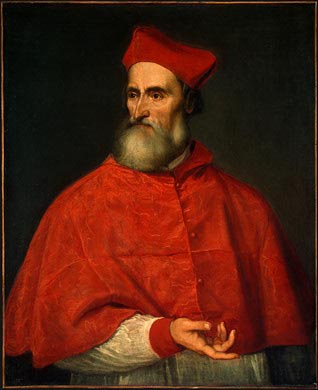
I wanted Aaron’s costume to be as historically accurate as possible, but found so little information on the topic of cardinal attire in the Renaissance, that it turned into a research project. Below is more about the costume I assembled, along with my theories on the subject. His costume is based on cardinal portraits from 1510-40s. Below you will find a link to a Gallery of images I put together as a reference for this project. A newer version of this costume which was completed in 2011, is also linked below.
Research: There seem to be no extant clergy garments from this period, although plenty of church vestments have survived. Not surprisingly, the research I found had mostly to do with these vestments, and not the “everyday” wear of the clergy. Thus this undertaking. Since I have no religious background myself, and limited historical costuming experience, I am sure I have made oversights and errors. And as all research tends to go, after completing this project I found more resource materials that could possibly have been of use. So perhaps I will get back to this sometime.
The Portrait (above): Titian, 1540: Cardinal Pietro Bembo. This was the painting that inspired the project, but I borrowed from several Italian Cardinal portraits of the era, for various elements of the costume.
Pietro Bembo (1470-1547), son of a noble family, was a famous Italian scholar who was made cardinal in 1539 by Paul III. He published many written works, and is credited for helping to create a common literary language in Italy. He probably commissioned Titian to paint this portrait of himself.
Patterns Used: Janet Arnold’s “1600 Loose Gown” as Red Soutane with modified neck and sleeves, Alcega’s “Bishop’s mantle and amice f.42” for hood of Mozzetta, and my own patterns for Mozzetta and Biretta (hat).
The Elusive Soutane (Cassock) : This was the long “cote” worn by clergy. Soutane seems to be the earlier word used to describe this article, but by 1592 at least, the word cassock is in use. Historically it was worn under vestments for ceremonial occasions, or under a tabard in colder weather. It was sometimes lined in fur. In Bembo’s portrait, the only bit of soutane that shows is the sleeve cuff.
My real dilemma was that I had no concrete evidence that the soutane I was copying (1540) had a front opening. What is evident is that by 1639, the soutane is a front-opening gown with buttons (Gaspard de Crayer, The Cardinal Infante). I scoured the web for more cardinals from the 1540s. Unfortunately, even in full-length portraits like the del Piombo, the soutane is obscured by a rochet of linen, which probably falls to mid-calf. An image between these two dates (El Greco, 1600: Cardinal Fernando Niño de Guevara) seems to reveal a front-opening at the bottom of the gown, but I cannot be sure. I suspect that Bembo’s soutane was styled like the later cardinals, although he could be wearing a robe like Inghirami’s (1515). Since that portrait is so different from Bembo’s, I opted for front-opening.
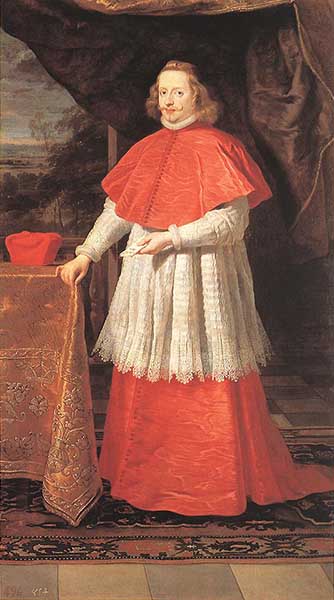
Gaspard de Crayer, 1639: The Cardinal Infante
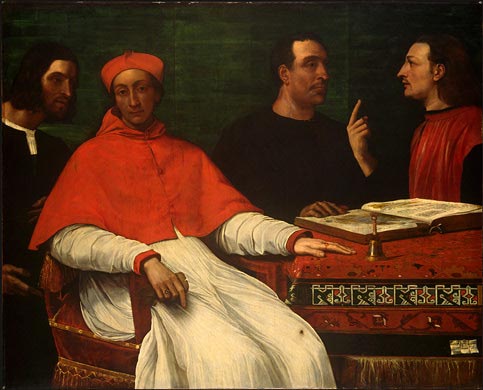
Sebastiano del Piombo, 1516: Cardinal Sauli
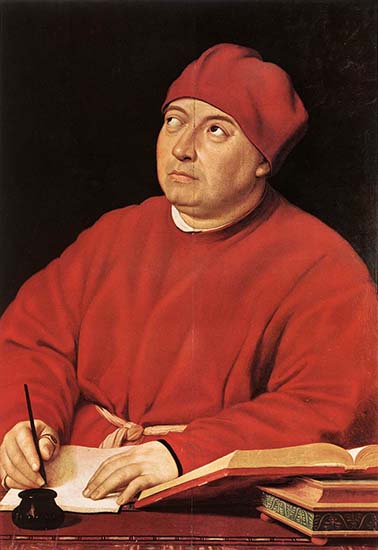
Raphael, 1515-16: Cardinal Inghirami
And lo and behold I found an actual pattern: Alcega’s Tailor’s Pattern Book of 1589 has a “Clerical cloak and soutane of cloth (f.44 and 44a).” The problem is that although I own this book, I’m still quite new to sewing and these ells intimidate me. So I also picked a pattern from Janet Arnold’s Patterns of Fashion, “1600 Loose Gown,” which had all the soutane elements I was looking for: floor in length, very full, and a button front opening. The two proved to be quite similar: I compared the general shape, arm fullness, and hem widths. Then I picked the POF pattern for simplicity. If I were doing this project again I might try to tackle Alcega’s instead.
I modified the POF pattern by taking in the arm width, lengthening the gown, and drafting a collar to resemble the pictures below. The hem is 1″ deep, hand-sewn, with wool selvages enclosed from my fabric stash to give it some weight.
In Titian’s portrait of Bembo, the white collar is probably the shirt (linen undershirt). What can be seen here I believe, is the collar of the soutane: a red one on a cardinal from the mid-1400s (left), and a black one on a bishop from 1505 (right). This low, roman collar would be well hidden by the mozzetta. The Alcega pattern has no collar piece at all. The various layers are also illustrated on this cardinal: the white shirt, next the soutane, then the rochet of linen, and then the final red outer layer (in the Titian, the mozzetta).
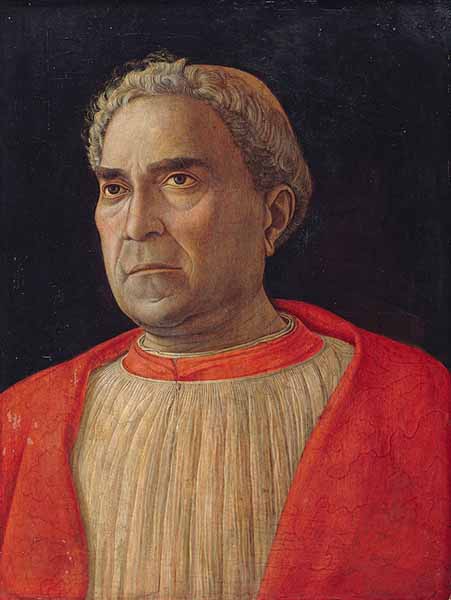
Andrea_Mantegna, 1459: Cardinal Lodovico Trevisano
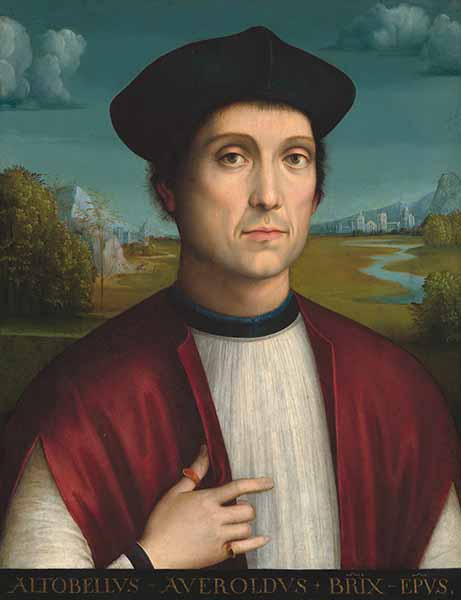
Soutane collar on bishop.
Francesco Francia, 1505: Bishop Altobello Averoldo
Mozzetta (Red Hooded Cloak): In all likelihood, the mozzetta was made from the same cloth as the soutane. I used Raffaello Sanzio’s Cardinal for my pattern, as I have a soft spot for this portrait. It’s a very simple circular cloak with a hood. The vertical seams at the arms would allow the pattern to fit onto the narrower fabric widths of the time as Patterns of Fashion illustrates. There is a horizontal seam across the chest. (I’m not sure what purpose it serves but I did include it). I did not draft this horizontal seam into the back as it does not appear in the rare side view of a mozzetta above.
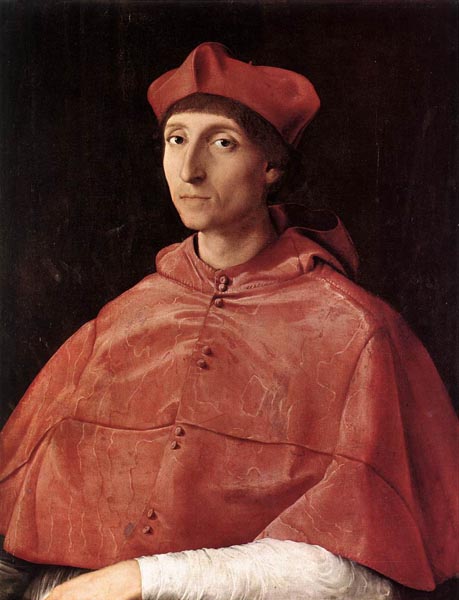
Raffaello Sanzio, 1510-11: Portrait of a Cardinal
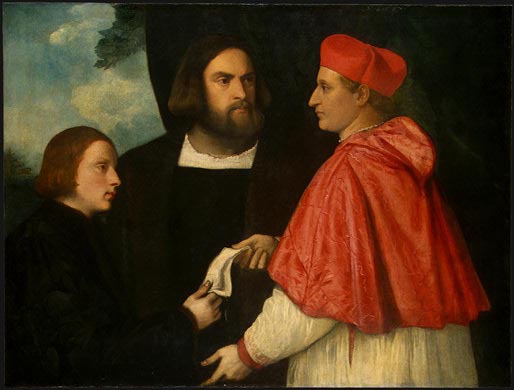
Titian and workshop, 1520: Girolamo and Cardinal Marco Corner
For the pointy hood and collar, I used Alcega’s “Bishop’s mantle and amice (f42),” and added a vertical seam to the neck. But the hood was teeny-weeny! It was at least 5″ shy of fitting over Aaron’s head. At first I thought I must have just gotten those Alcega measurements all wrong so I enlarged the pattern.
But this continued to bother me so I went looking for bishops to see if I could shed any light on this Alcega pattern. When I came across this Lorenzo Lotto bishop’s portrait, and made another examination of the cardinals, I decided that these hoods must have been non-functional. The top of this hood lies right at his neckline. In order for it to cover his head it would need to fall down his back, at least by a bit. My theory is the hood was made small for comfort (less heavy on the back and less cumbersome), while still retaining the traditional look of the middle ages. So I left the tiny Alcega hood as it was for Aaron’s mozzetta.
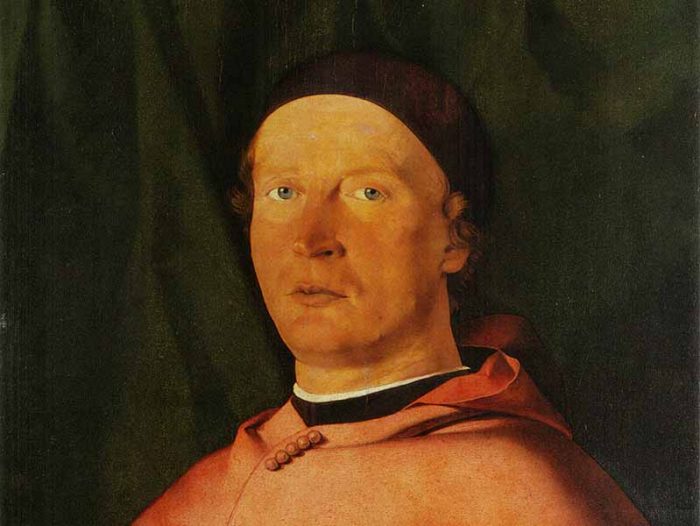
Lorenzo Lotto, 1505: Portrait of Bishop Bernardo de’ Rossi
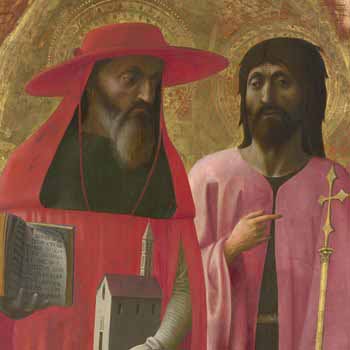
Masaccio, 1428: St Jerome and St John the Baptist, Panel, National Gallery, London
I made the soutane and mozzetta lapping the “wrong way” (right laps over left). Two reasons for this: 1) The original image I had of Titian’s Portrait of Alessandro opened this way, as do some of the doublets in Arnold’s POF, and 2) I had sewn the right side straighter than the left. As I was putting together this construction page, I found another copy of the Alessandro portrait flipped the other way so that it laps correctly! I am unable to verify which painting is the correct version.
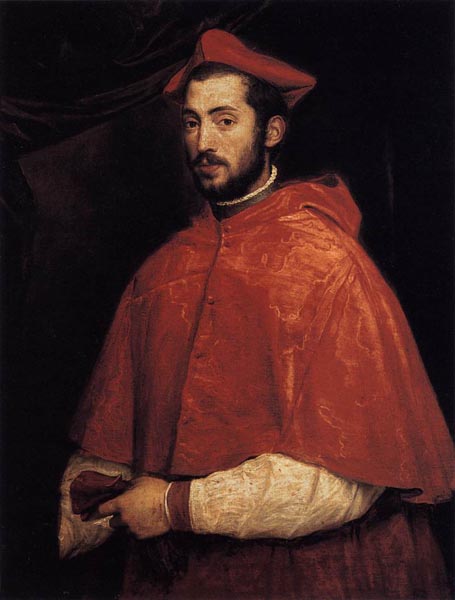
Titian, 1545: Portrait of Cardinal Alessandro Farnese
Fabric: Appears to be silk or wool, probably depending on the weather and occasion. For Aaron’s purposes wool was just too hot, plus we couldn’t find any in the right shade. Silk would have been nice, but also a bit pricey, so we went with red cotton twill, using the “bad” side out. JoAnns had exactly 7 ½ yards of red twill in the right shade, and by the time I was done all that was left over were scraps. The mozzetta was lined in red silk charmeuse, because I thought something in his costume should be of a higher grade fabric.
Buttons: I had wanted to make twill self-fabric buttons, but the twill was too thick to squeeze into the buttons, so I used silk instead. It gives the costume a nice flare. On Aaron’s there are 33 size 16 self-fabric buttons on the soutane. (One for each year Christ was alive, as I read was the current tradition). One hook holds the collar together. There are nine more buttons along the mozzetta. On mine, all the buttonholes are machine made, and it still took a full day to sew them.
I used the 1639 Gaspard de Crayer cardinal above, as my model for the arrangement of the buttons in threes. I feel compelled to point out that 3 divides very nicely into 33, which is why I liked this portrait. But this cardinal would actually need about 48 buttons if his soutane were to close all the way to the top. I have since found references to 39, not 33, as being the proper number of buttons on today’s cassock. What I conclude from all this is either: (A) the 33 button tradition does not go back this far, or (B) the soutane did not button all the way up, but stopped somewhere between the waist and the chest, depending on whether one picks 33 or 39 as the correct number. Given my earlier assumptions, I believe the first to be more likely. In the end, I still have no idea how many buttons adorned Bembo’s soutane.
Biretta (hat): The hat for my first cardinal costume was quickly abandoned. This version, completed in May 2007 is silk taffeta covering a structure of wire and buckram. I modeled it after a Titian from the 1520s.
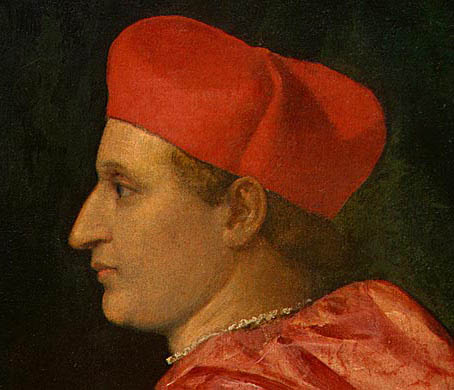
Titian and workshop, 1520: Girolamo and Cardinal Marco Corner
Rochet of Linen (Rochetta): Although I did start on a rochet, I had difficulty with the construction. My best guess as to a pattern was something like the camica (see page with 16thC Linens), with large square panels and underarm gussets. But I couldn’t figure out how to make it fall in those lovely little pleats. No matter what method I used to gather the linen, it still fell into large folds at the bottom. Furthermore, even with a 60″ panel of handkerchief linen for the front, my rochetta looked skimpy. It seemed I would need much more fabric to achieve the right look. On the other hand, I couldn’t imagine that much more linen was going to squeeze into the already bulky neckline. Aaron thought it was pretty uncomfortable, and his rochetta was soon recycled into a lower-class camica for myself. But there may be a solution to this neckline in Cut My Cote, which I recently discovered.
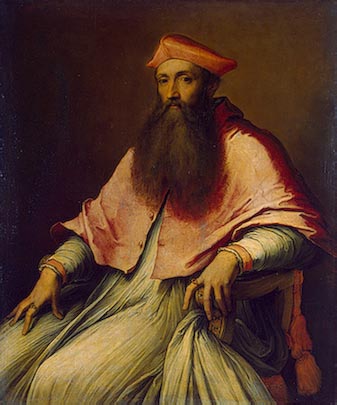
Sebastiano del Piombo, 1545-46: Portrait of Cardinal Reginald Pole
Despite my construction dilemmas, I ultimately ditched the rochetta because it covered up so much of the costume. I just didn’t like it. What was the point of sewing on all those buttons? I wasn’t clear on whether a Cardinal would appear in public in 1540 with a soutane and mozzetta, but without his rochetta. Later images seem to corroborate this, but there was no early evidence.
Accessories: As a finishing touch, he needed a red ring. And we found one at the antiques fair, in the shape of a cross, that fits on his fifth finger. But we later picked up a nice red cabochon set in a simple band, at the Renaissance Faire, which was so much better. He already had a white linen shirt (not entirely period, but it doesn’t show much anyway). I think it would be fun to make red hose, but for now it’s red trouser socks. Here you can see a 1600 cardinal wearing his red shoes too.
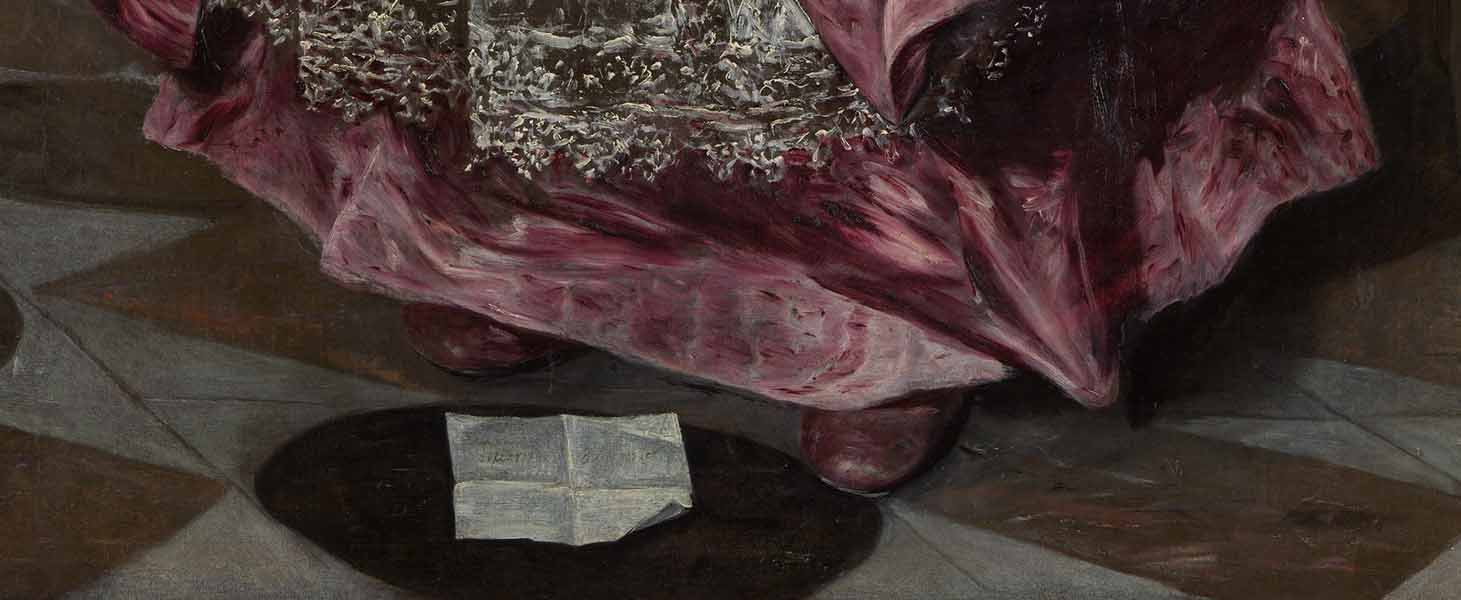
El Greco, 1600: Cardinal Fernando Niño de Guevara
